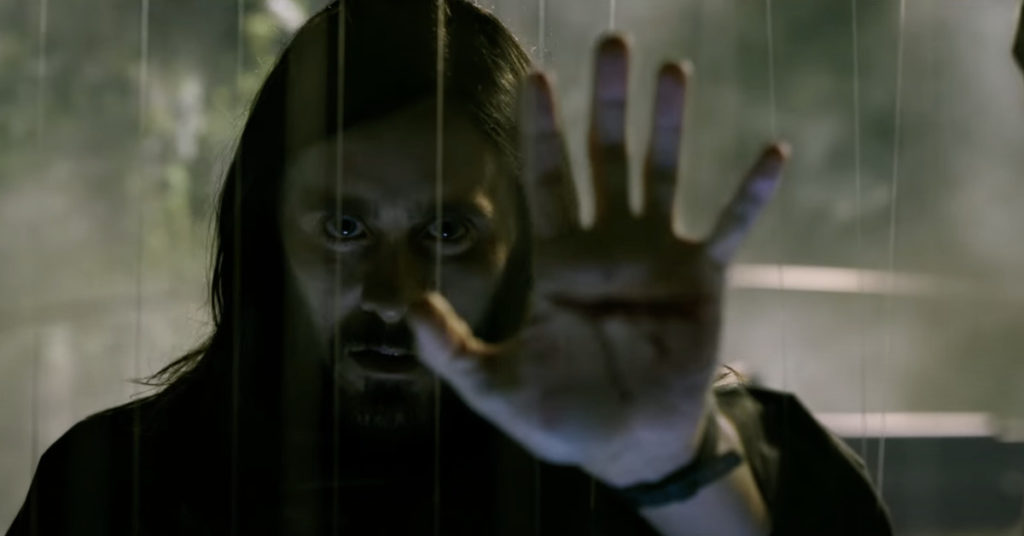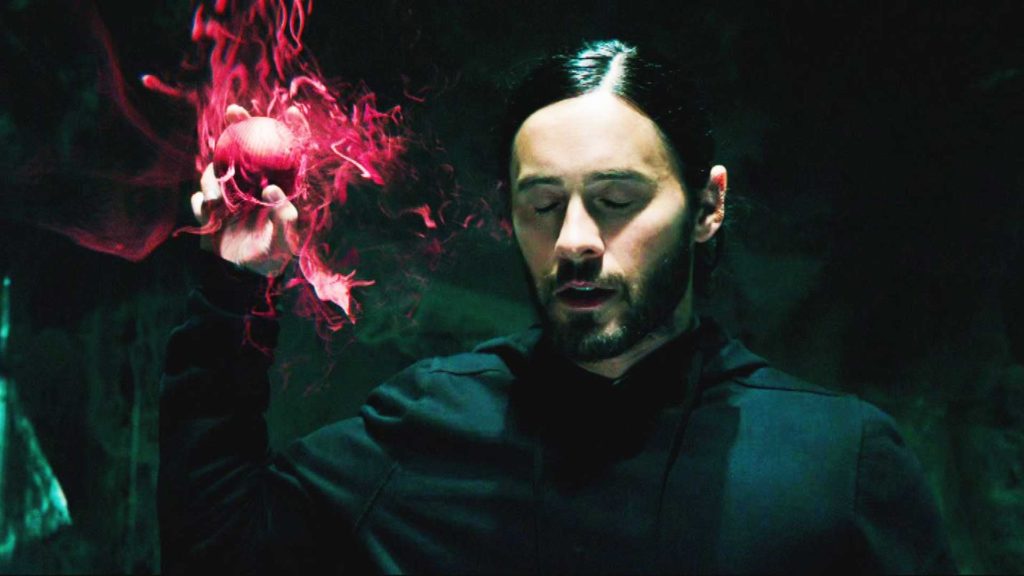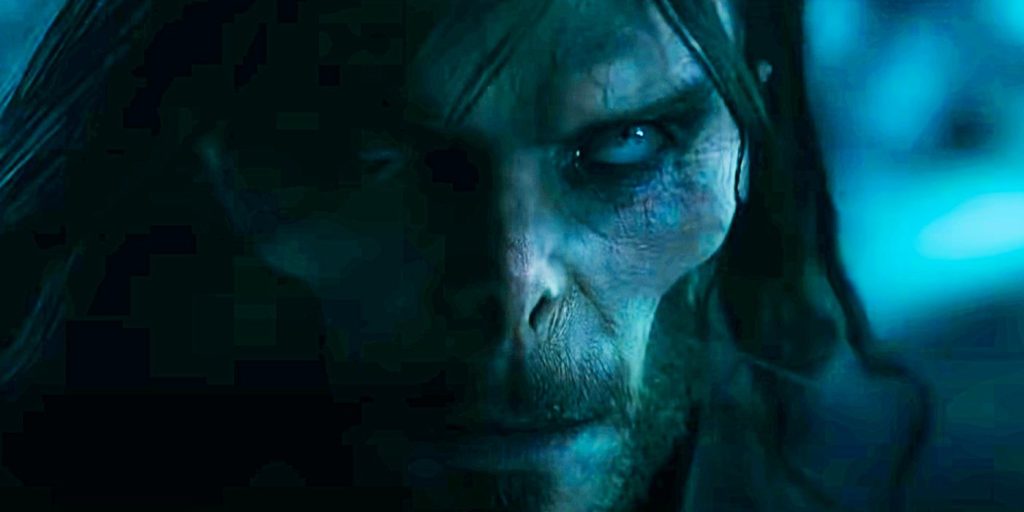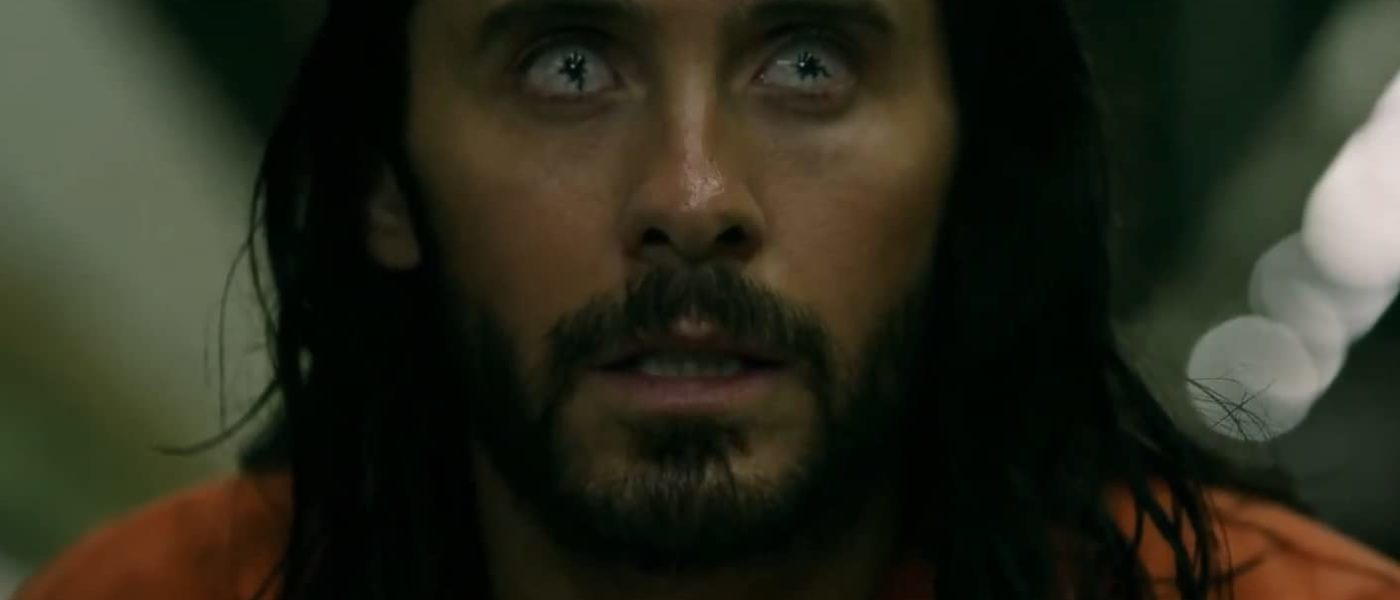Jared Leto, Undead and Loving it.
DIRECTED BY DANIEL ESPINOSA/2022

Looking gravely emaciated and weirdly entitled to it, Jared Leto takes the tortured lead in the latest checkmark on the Marvel movie pull list, the vampiric Morbius. Although Morbius is not a film of the MCU (Marvel Cinematic Universe) proper, in the realities-merging wake of the most recent Spider-Man movie, it might as well be. In that sense, and in that sense only, it joins such lower tier source material as Eternals, Shang-Chi, Moon Knight, and even Guardians of the Galaxy in finally ascending into A-list live action. With all of that and so much more becoming reality, it’s safe to say that we as a culture have hit the level of peak nerd-out.
Which is not to say Morbius is a nerdy movie. Maybe it is, maybe it isn’t. It certainly doesn’t want to look and feel like one- but then again, which do? The point is, very little of this dark and ominous potboiler screams “superhero”. Rather, it feels more like a digitally grim Underworld movie, or a brooding disposable one-off based on nothing in particular; the kind of meh that would’ve graced theater screens in the 1990s. The difference is, Morbius has superior visual effects (Check out those wispy color vapors that trail behind these characters as they fly!) and an impressive cast (including Jared Harris as a mentor type, and Al Madrigal and Tyrese Gibson as lite-comedy relief FBI agents who net an awful lot of screen time). It’s all better than the screenplay deserves, quite frankly.

Leto enthusiastically plays Dr. Michael Morbius, a brilliant but eccentric scientist of blood diseases who’s suffered all his life from a degenerative disease that must be tended to multiple times per day. Is transgenic vampirism the solution to his awful condition? Morbius is betting yes, as vampire bats and their rare qualities have driven his research. His central obsession is such that he’s installed a huge round glass enclosure full of hundreds of said bats in the middle of his high-tech laboratory. Sometimes he dissects one. Mostly, they fly around in ominous spirals. One day, when the research is looking up, he goes all in, literally. To truly live again, Dr. Morbius must first die. Except, his scientifically engineered rebirth isn’t exactly what he had in mind.
It should be noted that the good doctor’s research is not entirely self-motivated. His childhood best friend, Milo (also known as Lucien), has suffered the same disease. Tired of seeing Milo get bullied for his condition, Michael vows to one day help him. Adulthood sees Milo (Matt Smith) very wealthy, with Michael still working to make good with a cure. When Michael becomes transformed into an even more distorted being after running his bat-fueled experiment on himself, Milo opts to follow suit, thereby making the same trade of one problem for another. But Milo quickly gives in to the vampiric bloodlust whereas Michael spends the rest of the movie fighting it, lest he lose control and harm his fiancée and medical partner, Martine Bancroft (Adria Arjona). So, we have our bad guy. We also have no surprises from here on- not unlike everything that precedes. Which is a shame (if also not a surprise), considering that Morbius himself sparked to life in a moment rife with unpredictability.
*****
Before Thomas & Kane was a fake brand name on fashion posters adorning the background of this movie, they were the creative team that originally created Morbius the Living Vampire on the comic book page. Writer Roy Thomas & artist Gil Kane, to be more specific. To be even more specific, the bloodshot and pale fang-face first turned up in a supporting role in Amazing Spider-Man #101. This was 1971, the very year that pop culture reached a brilliant apex in terms of not knowing what to do with itself. Only in the broader bewildering uncertainty of that exact calendar moment could bands like Steely Dan, Roxy Music, and Queen not only form, but explode. Comics were not immune to such weird upheaval in the air, as Amazing Spider-Man #101 marked the first time someone other than Stan Lee would write the book. With the spark of recently revitalized onscreen horror still lingering, ushering an unusual vampire into the four-color fold was rightly bold at the time.

In keeping, Swedish filmmaker Daniel Espinosa directs Morbius with a semi-noteworthy flair. Mostly, he appears to be simply channeling his inner-Nicholas Winding-Refn. It’s difficult, though, to pin down his visual style. He truly commits to keeping the eye busy, with action that zigs all over the frame in different directions. But then, superhero movie fans are accustomed to constantly scanning the frame for hidden extra details. In this case, it’s mandatory just to track what’s happening. But the question is, is this slop? The jury is still out on that…
Consider a reoccurring shot that Espinosa seems fond of: a static reactionary close-up of the protagonist in quarter profile. In it, the eyes and ears of Morbius, now a “living vampire”, digitally transform back and forth from human to bat-like. The shot, however, is such that his eyes are at one end of the frame, his ear at the other. It’s nothing flashy, or even all that memorable in a movie like this. What makes it strange is that Espinosa chooses not to direct our eye from either transforming point. There is no subtle rack focus, camera move, or blocking shift. It’s just there, happening. Were this a prestigious project by a proven filmmaker, we wouldn’t hesitate in commending how he or she is making us do the work of deciding what to look at. Whatever the intentionality, the case can be made that the life with which Espinosa is able to imbue this film is not much of a life at all.

Some might say that “vampiric” is an apt description of the Marvel movie phenomenon upon the rest of contemporary cinema. Here, with that metaphor attacking outright while also coming home to roost, Marvel Studios may finally be made to pay the Piper. By that I mean, in having opened the gate of a stronger-than-previous association with these so-so “Sony Spider-Man Universe” (we’re apparently supposed to call it the “SSU”) programmers can’t possibly be good for the powerful brand in the long run.
The MCU multiversal connections have been and remain slight- not that it currently matters to the legion of energized fans. But as the unmemorable, cookie-cutter nature of movies like this become the norm (a norm that more cynical critics say has always been the case for Marvel Studios proper), the MCU can and will eventually be deemed guilty by association. To be clear, all MCU movies to date are better than this SSU movie. (Or any SSU movie). Sony, though, is working extra hard to beat that “Marvel” drum for Morbius, looking to capture some of that must-see status. If anything, it’s one studio feeding on another, the latter having struck that draining bargain years ago when it got to include Spider-Man alongside of the Avengers. No matter one’s appetite for such fare, Morbius, despite the efforts covered, is just another infused I.P. in its prolonged march of undead cinema.


